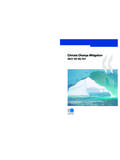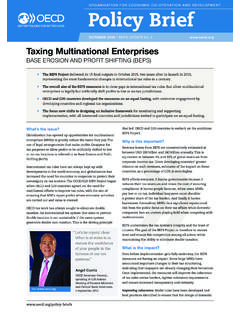Transcription of OECD‑FAO Agricultural Outlook 2017‑2026
1 OECD FAO Agricultural Outlook 2017 2026 . Special focus: Southeast Asia OECD-FAO. Agricultural Outlook 2017 - 2026 . This work is published under the responsibility of the Secretary-General of the OECD and the Director-General of the FAO. The opinions expressed and arguments employed herein do not necessarily reflect the official views of OECD member countries, or the governments of the FAO. member countries. This document and any map included herein are without prejudice to the status of or sovereignty over any territory, to the delimitation of international frontiers and boundaries and to the name of any territory, city or area. The designations employed and the presentation of material in this information product do not imply the expression of any opinion whatsoever on the part of the Food and Agriculture Organization of the United Nations concerning the legal or development status of any country, territory, city or area or of its authorities, or concerning the delimitation of its frontiers or boundaries.
2 The names of countries and territories used in this joint publication follow the practice of the FAO. Please cite this publication as: OECD/FAO ( 2017 ), OECD-FAO Agricultural Outlook 2017 - 2026 , OECD Publishing, Paris. ISBN 978-92-64-27547-8 (print). ISBN 978-92-64-27550-8 (PDF). ISBN 978-92-64-27548-5 (epub). Series: OECD-FAO Agricultural Outlook ISSN 1563-0447 (print). ISSN 1999-1142 (online). FAO. ISBN 978-92-5-109808-0. The statistical data for Israel are supplied by and under the responsibility of the relevant Israeli authorities. The use of such data by the OECD is without prejudice to the status of the Golan Heights, East Jerusalem and Israeli settlements in the West Bank under the terms of international law. The position of the United Nations on the question of Jerusalem is contained in General Assembly Resolution 181(II) of 29.
3 November 1947, and subsequent resolutions of the General Assembly and the Security Council concerning this question. Photo credits: Cover Original cover concept designed by Juan Luis Salazar. Adaptations by OECD. Corrigenda to OECD publications may be found on line at: OECD/FAO 2017 . You can copy, download or print OECD content for your own use, and you can include excerpts from OECD publications, databases and multimedia products in your own documents, presentations, blogs, websites and teaching materials, provided that suitable acknowledgment of OECD and FAO as source and copyright owner is given. All requests for public or commercial use and translation rights should be submitted to Requests for permission to photocopy portions of this material for public or commercial use shall be addressed directly to the Copyright Clearance Center (CCC).
4 At or the Centre fran ais d'exploitation du droit de copie (CFC) at FOREWORD. Foreword T he food and agriculture sector is faced with a critical global challenge: to ensure access to safe, healthy, and nutritious food for a growing world population, while at the same time using natural resources more sustainably and making an effective contribution to climate change adaptation and mitigation. Through this annual collaboration and other studies, the Organisation for Economic Co-operation and Development (OECD) and the Food and Agriculture Organization of the United Nations (FAO) are working together to provide information, analysis and advice, to help governments achieve these essential objectives. This is the 13th joint edition of the OECD-FAO Agricultural Outlook . It provides ten-year projections to 2026 for the major Agricultural commodities, as well as for biofuels and fish.
5 The pooling of market and policy information from experts in a wide range of participating countries provides a benchmark necessary for assessing the opportunities and threats to the sector. This year's Agricultural Outlook includes a special focus on Southeast Asia, a region where agriculture and fisheries have developed rapidly and undernourishment has been significantly decreased, but also a region that is on the front line of the effects of climate change and where there are rising pressures on natural resources. The Agricultural Outlook comes in the context of a wider set of international efforts to address food security and Agricultural issues. Two global initiatives stand out: The UN Sustainable Development Goals (SDGs) set ambitious targets to be achieved by 2030. Among these, the first goal is to end poverty in all its forms everywhere, while the second goal pledges to end hunger, achieve food security and improved nutrition, and promote sustainable agriculture.
6 The two goals are related as more than three-quarters of the world's poor depend on agriculture not only for their food, but also for their livelihoods. Under the United Nations Framework Convention on Climate Change's 2015 Paris Agreement, 195. countries have committed to take action to contain the increase in global average temperatures to well below 2 C above pre-industrial levels. Climate change poses a threat to sustainable food production, but agriculture, which accounts for more than a fifth of all greenhouse gas emissions, can be an active part of the solution The Agricultural Outlook supports these global initiatives by providing a benchmark against which to assess the implications of alternative policies that seek to increase the availability of food sustainably while mitigating greenhouse-gas emissions.
7 Such policies include both supply-side measures, such as measures for increasing sustainable productivity growth in agriculture, and demand-side measures for encouraging the reduction of waste and overconsumption. The OECD and FAO are working across the board to support the global effort to eradicate poverty and tackle climate change. In 2016, Agriculture Ministers convened at both the OECD and FAO in order to chart directions for future policies that can meet these commitments. At the OECD meeting, Ministers stressed that policies must promote the resilience, as well as the productivity and sustainability of the agriculture and food sector and rural communities. They also recognised that OECD-FAO Agricultural Outlook 2017 - 2026 OECD/FAO 2017 3. FOREWORD. achieving those shared goals will require sustained international co-operation.
8 At the FAO meeting, which also involved Trade Ministers, they underlined the importance of Agricultural commodities for growth in developing and less developed countries and cautioned about the risks posed by climate change. They also stressed the importance of market transparency and policy predictability, as well as the role that trade can play in adapting to climate change. Because the areas of projected food demand growth differ from the areas where supply can be increased sustainably, international trade will take on particular importance in the attainment of the SDGs, as well as in adapting to and mitigating climate change. The 11th WTO Ministerial Conference, to be held in Buenos Aires in December of this year, will undoubtedly be guided by the need to ensure the Agricultural sector makes these global contributions effectively, while also addressing specific food-security concerns in developing countries.
9 Food security and Agricultural issues have received specific attention in international fora such as the G20 and the G7. A significant initiative was the G20's Agricultural Market Information System (AMIS), which is housed at the FAO and to which the OECD and other international organisations contribute. With food prices now closer to long-term trend levels, it is important that the structural issues that remain are not neglected. Moreover, food markets are inherently volatile, and today's relative stability is no reason for complacency. More than ever, we must all work together to improve the sustainability of food systems and ensure global food security and healthy nutrition. We hope that our collaborative effort on the annual production of this report will continue to provide governments and all other stakeholders with a key element of the information they need to reach the goals set in the 2030 Agenda for Sustainable Development and the Paris Agreement Angel Gurr a, Jos Graziano da Silva, Secretary-General Director-General Organisation for Economic Food and Agriculture Organization Co-operation and Development of the United Nations 4 OECD-FAO Agricultural Outlook 2017 - 2026 OECD/FAO 2017 .
10 ACKNOWLEDGEMENTS. Acknowledgements T The Agricultural Outlook , 2017 - 2026 , is a collaborative effort of the Organisation for Economic Co-operation and Development (OECD) and the Food and Agriculture Organization (FAO) of the United Nations. It brings together the commodity, policy and country expertise of both organisations and input from collaborating member countries to provide an annual assessment of prospects for the coming decade of national, regional and global Agricultural commodity markets. The baseline projection is not a forecast about the future, but rather a plausible scenario based on specific assumptions regarding macroeconomic conditions, agriculture and trade policy settings, weather conditions, longer term productivity trends and international market developments. The Agricultural Outlook is jointly prepared by the OECD and FAO Secretariats.











